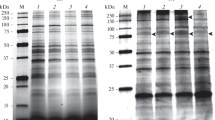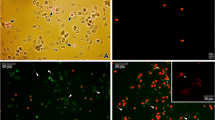Summary
Six-day-old Hymenolepis diminuta from the rat was cultivated in a modification of the diphasic medium described by Schiller (1965). The modified medium contained defibrinated horse blood. In this medium worms increased in length, segmented, developed to maturity and produced preonchospheres. A diphasic serum-agar medium without blood was developed which contained horse serum, yeast and liver extracts in the solid agar and supernatant fluid phases. In this medium worms grew as well as in Schiller's medium containing horse blood and produced onchospheres, but the worms tended to knot and fracture in both media.
Attempts to induce worms to migrate to lie beneath the solid phase of the diphasic serum-agar medium failed, consequently the volumes of the solid and fluid phases were modified. Worms migrated below the agar of the modified medium (14 ml of serum-agar, 22 ml of fluid overlay) and displayed reduced knotting compared with those remaining in the supernatant fluid. However, the immature anterior segments of worms which migrated, as with those that did not migrate, deteriorated and fractured.
Neither increasing the oxygen in the medium nor culturing worms in a monophasic medium in tubes prevented the deterioration of the immature segments, but worms grown in a medium preincubated in air (i. e. with more oxygen) had a higher dry weight than those cultivated in the same medium preincubated in 5% CO2 in N2. The replacement of horse serum in the monophasic medium with defibrinated horse blood did not prevent the degeneration of the immature segments.
Similar content being viewed by others
References
Evans, W. S.: The in vitro cultivation of Hymenolepis microstoma from cysticercoid to egg-producing adult. Canad. J. Zool. 48, 1135–1137 (1970).
Roberts, L. S., Mong, F. N.: Developmental physiology of cestodes IV. In vitro development of Hymenolepis diminuta in presence and absence of oxygen. Exp. Parasit. 26, 166–174 (1969).
Rybicka, K.: Embryogenesis in Hymenolepis diminuta. 1. Morphogenesis. Exp. Parasit. 19, 366–379 (1966a).
Rybicka, K.: In: Advances in parasitology (B. Dawes, ed.), vol. 4. London: Academic Press (1966b).
Schiller, E. L.: A simplified method for the in vitro cultivation of the rat tapeworm Hymenolepis diminuta. J. Parasit. 51, 516–518 (1965).
Schiller, E. L.: Personal communication to Professor C. A. Hopkins (1966).
Sinha, D. P., Hopkins, C. A.: In vitro cultivation of the tapeworm Hymenolepis nana from larva to adult. Nature (Lond.) 215, 1275–1276 (1967).
Turton, J. A.: Distribution and growth of Hymenolepis diminuta in the rat, hamster and mouse. Z. Parasitenk. 37, 315–329 (1971).
Author information
Authors and Affiliations
Rights and permissions
About this article
Cite this article
Turton, J.A. The in vitro cultivation of Hymenolepis diminuta: The culture of 6-day-old worms removed from the rat. Z. F. Parasitenkunde 40, 333–346 (1972). https://doi.org/10.1007/BF00328751
Received:
Issue Date:
DOI: https://doi.org/10.1007/BF00328751




